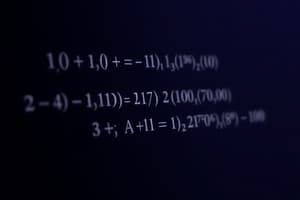Podcast
Questions and Answers
Which of the following phrases best describes the meaning of the title 'Christ'?
Which of the following phrases best describes the meaning of the title 'Christ'?
- The one who is to come
- He who sanctifies the Church
- The object of the hope of Israel
- Anointed One (Messiah) (correct)
According to the Gospel of Matthew, what does the name 'Emmanuel' signify?
According to the Gospel of Matthew, what does the name 'Emmanuel' signify?
- God is with us (correct)
- The original sacrament
- The Lord saves
- Praise to you, Lord Jesus Christ!
How does the Gospel of Matthew portray Joseph's initial decision upon discovering Mary's pregnancy?
How does the Gospel of Matthew portray Joseph's initial decision upon discovering Mary's pregnancy?
- He consulted the religious leaders for guidance.
- He publicly denounced Mary to ensure justice.
- He rejoiced and accepted the child as his own.
- He decided to divorce her quietly to avoid shaming her. (correct)
What does Baptism primarily symbolize?
What does Baptism primarily symbolize?
Which of the following is NOT considered one of the sacraments of Christian initiation?
Which of the following is NOT considered one of the sacraments of Christian initiation?
What is the significance of the Sacrament of Confirmation in relation to Baptism?
What is the significance of the Sacrament of Confirmation in relation to Baptism?
According to the threefold mission of Christ, what does it mean to be 'Prophetic'?
According to the threefold mission of Christ, what does it mean to be 'Prophetic'?
Which of the following actions aligns with the 'kingly' aspect of the threefold mission of Christ?
Which of the following actions aligns with the 'kingly' aspect of the threefold mission of Christ?
Why is Baptism called the 'Sacrament of Faith'?
Why is Baptism called the 'Sacrament of Faith'?
What effect does Baptism have on original and personal sins?
What effect does Baptism have on original and personal sins?
What does Baptism help us to do with regard to our actions and Christ?
What does Baptism help us to do with regard to our actions and Christ?
Which of the following is highlighted as one of the truths that infant Baptism reveals?
Which of the following is highlighted as one of the truths that infant Baptism reveals?
What are the sacraments of vocation/ministry directly intended to do?
What are the sacraments of vocation/ministry directly intended to do?
According to the information on 'Foundation for the Needy', which program is described as 'Back to Home'?
According to the information on 'Foundation for the Needy', which program is described as 'Back to Home'?
What is emphasized as an element that is always present in a sacrament?
What is emphasized as an element that is always present in a sacrament?
Flashcards
Baptism Importance
Baptism Importance
Baptism is the first sacrament and through which we are able to receive the other sacraments.
Baptism: Sacrament of Faith
Baptism: Sacrament of Faith
Baptism is rightly called the sacrament of faith because in asking to be baptized we are asking God's Church for the gift of Faith.
What Is Baptism?
What Is Baptism?
Baptism is the first step in Christian initiation and is a sacrament of faith that brings us new life in Christ and forgiveness of sins through water and the Spirit.
Baptism Meaning
Baptism Meaning
Signup and view all the flashcards
Incarnation
Incarnation
Signup and view all the flashcards
Anointing of the Sick
Anointing of the Sick
Signup and view all the flashcards
Study Notes
Chain Rule
- For functions $f: A \subseteq \mathbb{R}^n \longrightarrow \mathbb{R}^m$ and $g: B \subseteq \mathbb{R}^m \longrightarrow \mathbb{R}^k$ with $f(A) \subseteq B$, if $f$ is differentiable at $a \in A$ and $g$ is differentiable at $f(a) \in B$, then $g \circ f: A \subseteq \mathbb{R}^n \longrightarrow \mathbb{R}^k$ is differentiable at $a$.
- The derivative of the composite function is $(g \circ f)'(a) = g'(f(a)) f'(a)$.
- For $f: I \subseteq \mathbb{R} \longrightarrow \mathbb{R}^m$ and $g: B \subseteq \mathbb{R}^m \longrightarrow \mathbb{R}^k$ with $f(t) \in B$ for $t \in I$: $(g \circ f)'(t) = g'(f(t)) f'(t)$, where $(g \circ f)'(t) \in \mathbb{R}^{1 \times k}$, $g'(f(t)) \in \mathbb{R}^{m \times k}$ and $f'(t) \in \mathbb{R}^{1 \times m}$.
- Consequently, $\nabla (g \circ f)(t) = f'(t) \nabla g(f(t))$.
- If $f: A \subseteq \mathbb{R}^n \longrightarrow \mathbb{R}^m$ is differentiable at $a \in A$ and $g: B \subseteq \mathbb{R}^m \longrightarrow \mathbb{R}$ is differentiable at $f(a) \in B$, then $\frac{\partial (g \circ f)}{\partial x_i}(a) = \nabla g(f(a)) \cdot \frac{\partial f}{\partial x_i}(a)$ for $i = 1,..., n$.
Constant Function Theorem
- If $f: A \subseteq \mathbb{R}^n \longrightarrow \mathbb{R}$ is differentiable on $A$, $A$ is an open set, and $\nabla f(x) = 0$ for all $x \in A$, then $f$ is constant on $A$.
- For any $a, b \in A$ there exists a polygonal path $\gamma$, where $\gamma(t) = x_0 + t(x_1 - x_0)$, $t \in [0,1]$, and $x_0, x_1 \in A$.
- Given $g(t) = f(\gamma(t))$, the chain rule implies $g'(t) = \nabla f(\gamma(t)) \cdot \gamma'(t) = 0$.
- $g$ is constant on $[0,1]$, indicating $g(0) = g(1)$ and $f(x_0) = f(x_1)$, affirming that $f(a) = f(b)$, thus, $f$ is constant on $A$.
Symmetry of Second Derivatives
- For $f: A \subseteq \mathbb{R}^n \longrightarrow \mathbb{R}$, a $C^2$ function on $A$, $D^2f(x)$ is symmetric for every $x \in A$, implying $\frac{\partial^2 f}{\partial x_i \partial x_j}(x) = \frac{\partial^2 f}{\partial x_j \partial x_i}(x)$.
- For a function $f: A \subseteq \mathbb{R}^2 \longrightarrow \mathbb{R}$, $a \in A$, let $h, k \in \mathbb{R}$ form a rectangle $R$.
- By defining $\varphi(x) = f(x, a_2 + k) - f(x, a_2)$, it can be shown that $\Delta = \frac{\partial^2 f}{\partial x_2 \partial x_1}(c, d)hk$ where $\Delta = f(a_1 + h, a_2 + k) - f(a_1 + h, a_2) - f(a_1, a_2 + k) + f(a_1, a_2)$.
- Defining $\psi(y) = f(a_1 + h, y) - f(a_1, y)$, therefore $\Delta = \frac{\partial^2 f}{\partial x_1 \partial x_2}(\tilde{d}, \tilde{c})hk$.
- As $(h, k) \longrightarrow (0, 0)$, it follows that $(c, d) \longrightarrow (a_1, a_2)$ and $(\tilde{d}, \tilde{c}) \longrightarrow (a_1, a_2)$
- $f \in C^2(A)$, which implies that $\frac{\partial^2 f}{\partial x_2 \partial x_1}(a_1, a_2) = \frac{\partial^2 f}{\partial x_1 \partial x_2}(a_1, a_2)$.
Second Derivative Test
- For $f: A \subseteq \mathbb{R}^n \longrightarrow \mathbb{R}$, $C^2$ function on an open set $A$, where $a \in A$ is a critical point of $f$ with $\nabla f(a) = 0$:
- If all eigenvalues of $D^2f(a)$ are positive, then $f$ has a local minimum at $a$.
- If all eigenvalues of $D^2f(a)$ are negative, then $f$ has a local maximum at $a$.
- If $D^2f(a)$ has both positive and negative eigenvalues, then $f$ has a saddle point at $a$.
Complex Numbers: Algebraic Form Comparison
- Given $z = a + bi$ and $z' = a' + b'i$ with $a, a', b, b' \in \mathbb{R}$:
- $z = z'$ only if $a = a'$ and $b = b'$
Complex Numbers: Module and Argument Comparison
- Given $z = [r, \theta]$ and $z' = [r', \theta']$, $r, r' \in \mathbb{R}_+$ and $\theta, \theta' \in \mathbb{R}$:
- $z = z'$ if and only if $r = r'$ and $\theta = \theta' [2\pi]$
- $|z| = |z'|$ if and only if $r = r'$
- $arg(z) = arg(z')$ if and only if $\theta = \theta' [2\pi]$
Note on Order
- Complex field does not have a natural ordered relationship , therefore $z>z'$ and $z<z'$ are invalid statements
Population Genetics study areas
- The study of genetic variation within populations
- The study of how genetic variation changes over time
Definition of Population
- A group of interbreeding individuals
- Individuals of the same species
- Individuals that live in the same area
Allele
- Variant of a gene
Gene Pool
- The set of all alleles within a population
Tracking in Population Genetics
- Allele frequency: the proportion of times a specific allele occurs in a population
- Genotype frequency: the proportion of times a specific genotype occurs in a population
Calculation
- Calculation of of allele frequencies can be done from genotype frequencies
Hardy-Weinberg Model Description
- A null model
- The model describes the conditions under which allele and genotype frequencies in a population will remain constant from generation to generation
Hardy-Weinberg Equilibrium
- population is not evolving
- The allele frequencies are in Hardy-Weinberg equilibrium (HWE)
Hardy-Weinberg Model Assumptions
- There is no mutation.
- There is no gene flow (migration).
- The population is infinitely large (no genetic drift).
- There is no natural selection.
- Mating is random (no sexual selection).
Equation Set
- p + q = 1
- $p^2 + 2pq + q^2 = 1$
Where:
- p is the frequency of the dominant allele
- q is the frequency of the recessive allele
- $p^2$ is the frequency of the homozygous dominant genotype
- 2pq is the frequency of the heterozygous genotype
- $q^2$ is the frequency of the homozygous recessive genotype
- These equations to determine if a population is in Hardy-Weinberg equilibrium.
Butterfly Example
- A population of butterflies has two alleles for wing color: black (B) and white (b).
- black allele (B) is 0.7
- white allele (b) is 0.3 What are the expected genotype frequencies?
- BB: 0.49
- Bb: 0.42
- bb: 0.09
Chi-Square Test
- comparison the observed genotype frequencies to the expected genotype frequencies
- Formulafor the Chi-square test:
$\chi^2 = \sum \frac{(O-E)^2}{E}$, where:
- Ois the observed frequency
- Eis the expected frequency -one degree of freedom (number of genotypes - number of alleles)
Use of Chi-square value
- Determined by comparing the calculated Chi-square value to a critical value
Rejecting the null hypothesis
- the calculated Chi-square value is greater than the critical value,
- he population in Hardy-Weinberg equilibrium should be rejected
Quantum Mechanics Definition
- description of nature's physical attributes
- atomic and subatomic level
Quantum Mechanics Core Features
- Quantization
- energy and angular momentum, can only take on defined values
- Wave-Particle Duality
- Particles behave like waves
- Particles behave like matter
- Uncertainty Principle
- simultaneous position and momentum precision is limited
- Superposition
- single multiple state existence
- Entanglement
- Interconnected particles fate
Quantum Mechanics Mathematical Formulation
- Described by wave function denoted as $\psi$
- Wave function is a number with values in accordance to spatial coordinates plus time
Schrodinger Equation
$i\hbar\frac{\partial}{\partial t}\psi(r,t) = \hat{H}\psi(r,t)$
- $i$ is the imaginary unit,
- $\hbar$ is the reduced Planck constant,
- $\psi(r,t)$ is the wave function,
- $\hat{H}$ is the Hamiltonian operator, which represents the total energy of the system.
Physical Observables
- Linear operators represent physical observables
- Eigenvalues are the values that can be observed
Key Experiments
- Double Slit Experiment
- demonstration of wave-particle duality
- Quantum Tunneling
- particles overcoming potential barriers
Quantum Computing Application
- computers use quantum mechanics
- classical computers impossible computations can be performed
Quantum Cryptography Application
- data transmitted securely with encryption
- uses quantum mechanics
Quantum Sensors Application
- highly sensitive measurements of physical quantities with the use of quantum mechanics mechanisms
Game theory definition
- mathematical models of strategic interactions among rational agents
Game Keys
- players set
- rules set
- Timing of players' moves
- Moves at each Timing of players' moves
- Payoffs for action combinations
Prisoner's Dilemma
- minor offense: 1 year
- implicate the other: freed and 3 years in prison
- implicate each other: 2 years
Algorithmic game theory versus Clssical
- classical game theory lacks computational bounds
- algorithmic game theory lies at game theory and algorithm design
- incorporates computational complexity into game-theoretic models.
- it designs algorithms for solving game-theoretic problems.
- It studies strategic behavior effects on the performance of algorithms
Mechanism and Analysis
- Mechanism design: how to design rules of a game to achieve a desired outcome, even when players act strategically.
- Price of anarchy: how inefficient is the system due to selfish behavior of players.
- Solution concepts: how to define what it means to "solve" a game.
- Complexity of computing solutions: how hard is it to find a solution of a game.
Selfish Routing
- Each edge has a cost function which is the cost incurred when total traffic
- commodities each with a rate greater than 0
Defining flow
- a signment non-negative flow rate to each paths
- For each commodity all rates will match $$f_e = \sum_{p: e \in p} f_p$$
- The path cost is the latencies of its edges added $$l_p(f) = \sum_{e \in p} l_e(f_e)$$
- Flow incurred costs added $$C(f) = \sum_{p} f_p l_p(f) = \sum_{e} f_e l_e(f_e)$$
Nash Equilibrium
- no player can unilaterally improve its cost
- path choices won't influence overal equilibrium
Defintion
The $$PoA = \frac{\max_{f \in Nash} C(f)}{\min_{f \in Socially \ Optimal} C(f)}$$
- the worst case Nash equilibrium compared to op optimal results
- This ration defines price of Anarchy
Complex Numbers: Algebraic form
- For $z = a + ib$ and $z' = a' + ib'$
- $z = z' \Leftrightarrow a = a'$ and $b = b'$
- Si $z = 3 - 5i$ then $\Re(z) = 3$ and $\Im(z) = -5$
Definition
For $z = a + ib$ in which $a, b \in \mathbb{R}$
- $|z| = \sqrt{a^2 + b^2}$
-
$z = 3 - 4i$ then $|z| = \sqrt{3^2 + (-4)^2} = \sqrt{25} = 5$
-
$z = 5i$ then $|z| = \sqrt{0^2 + 5^2} = \sqrt{25} = 5$
-
Conjugué
Conjugate Definition
- $z = a + ib$ in which $a, b \in \mathbb{R}$
- $\overline{z} = a - ib$
Exemples
-
$z = 3 - 5i$ then $\overline{z} = 3 + 5i$
-
$z = 7i$ then $\overline{z} = -7i$
-
$z = 4$ then $\overline{z} = 4$
-
Module Defintion
- $\arg(z)$ a fixed points of $z$ defined by $\mathbb{C}^*$ which is the angle Exemples Si $z$ est un réel strictement positif then $\arg(z) = 0 [2\pi]$ are known to be complex
Forme trigonométrique definition
-
Defintion For $z \in \mathbb{C}^*$
-
$r = |z|$
-
$r = |z|$
Example
-
Forme exponentielle definiteion notation
- Exemple: $z \in \mathbb{C}^*$
-
$r = |z|$
-
$\theta = \arg(z)$
-
Example
Notation example Example: $z = 5e^{i\frac{\pi}{3}}$ has notation as above
Acids
- Substances forming the solution liberating an exclusive cation of Hydrogen ion
- Example H2O is formed
- Hydronium and hydroxide are formed
Acid Classifications
- Hydrogen counts are mono, bi, tri, and quadri
Acid Classes
- Oxygen presense is present
- Oxy groups are available
- Strength occurs: Strong: $HCl$ $HBr$ $HI$ Moderated: $HF$ HCN: Weak
- Oxyacids follow HXO sequence in descending strength
- n = 3 are strong acids
- if HXO nox is greater then 1 then the oxycadis is a Fracoacid
Diagram Structure
Diagram showing $OH^−$, $CH_3CH_2O^-$, $NH_2^-$, $H^-$, e $CH_3^-$ structures
Bases
- Anions with hydroxide from water
- $OH^−$
Base Classes
- Classified as mono, dy, tri, or tetragonal as per hydroxyl- number
- Soluble forms form solubles and insolubles
- Strong has solubles as a feature
- The remaining metals form WeakBase structure
Base Nomenclatures
- Naming features and element counts
- Metals as fixed, metal as variabble
- If the metal is variable we use (nox in algarismo romano)
Strong Forms
Diagram showing $OH^-$, $CH_3CH_2O^-$, $NH_2^-$, $H^-$, and $CH_3^-$ configurations
Algorithm
It is to determine vertices based on non-basic variables which are then moved until opamizatikon
Simplex Key Elements
- LP form must be known Where $A \in \mathbb{R}^{m \times n}$,$x \in \mathbb{R}^nand $b \ge 0$.
Algorithm Elements
-
Convert the LP to standard form.
-
Find a BFS.
-
Repeat the process at the optimal point
- a. Check for a basic
- b. Increase basic
- c. Decrease basic
- d. Swap if basic met and not
Graph Algorithms Core
- Weighted graphs with vertices and edges
- find path weight
- w: E → R≥0
- Output will show for each vertex what is the distance
Process Description
- Positive Edge Weights
- Vertices are in Light process
- Each is in short path
- The neighbor path to vertex process is to the right
Path process
- Vertex attribute maintains d and for vertex d the path estimate are maintained.
DIJKSTRA Description
- Vertices in V are set at infinity
- S is set at start point and set at 0
- If there is more than one edge to each vertex from start and you decide the shortest path,
- The values on the edges determine the route.
Studying That Suits You
Use AI to generate personalized quizzes and flashcards to suit your learning preferences.




